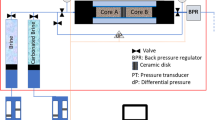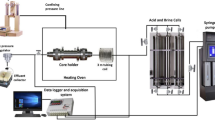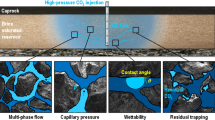Abstract
Underground storage of CO2 in geological structures is very often accompanied by chemical interactions between the storage rock formation, existing fluids (e.g. brine) and injected CO2. Depending on the mineralogy and initial petrophysical properties of the rock formation, such reactions may also alter the petrophysical properties of the rock through dissolution, precipitation, fines migration and compaction mechanisms. In fact, carbonate formations are often highly reactive with carbonated brine and the extent of any reaction often depends on the precise rock composition as well as the accessible surface area with the fluid; a higher surface area will typically increase the reaction rate for heterogeneous systems between solids and liquids. Furthermore, fracturing and weakening of oil-bearing chalk reservoirs are approaches that have been implemented to improve oil recovery from various fields worldwide. In this paper, we present the results of an experimental study on a heterogeneous chalk sample (calcite concentration > 98.9 wt%) which has been cut in half (to form an inlet and outlet sample) subjected to carbonated brine flooding under in situ reservoir conditions. The results show a significant increase in the post-flood permeability of the inlet plug and a slight decrease in the outlet plug. The increase in permeability of the inlet sample is supported by X-ray CT and SEM images which reveal significant mineral dissolution and establishment of preferential flow paths (or wormholes). On the other hand, dissolution is not observed in the outlet sample. This suggests that the fluid has reached equilibrium (i.e. achieved solute saturation) with the rock samples after traversing the first sample (i.e. there is no further mineral dissolution). This is strong evidence for the existence a dissolution front that forms during the core flooding process. With continued flooding of CO2-saturated brine, this front eventually traverses the whole sample and the dissolution becomes more substantial along the entire length of the core. As a result of the dissolution process, there is some degree of fines migration (induced by the dissolution in the first samples) into the outlet sample which has negative impacted its permeability. This change in permeability could also be caused by later precipitation of minerals from the brine, but this is likely a minor effect as the pore pressure/temperature conditions (for example, causing a pH change) do not vary significantly along the length of the samples. NMR T2 distribution analysis shows reductions in the porosity and pore sizes are observed in both inlet and outlet plugs of the composite sample and these changes are likely due to a combination of compaction (caused by dissolution-induced weakening) and mineral dissolution/precipitation.












Similar content being viewed by others
Availability of Data and Materials
All relevant data is included in the manuscript.
Code Availability
No custom code was used for this work.
References
Anders Nermoen, T.H.-H., Jettestuen, E., Vinningland, J.L.: Water weakening of chalk at realistic reservoir conditions. JCR-7 SYMPOSIUM (2014)
Asghari, K., Al-Dliwe, A.: Optimization of carbon dioxide sequestration and improved oil recovery in oil reservoirs. In: GHGT7 Proceedings, Vancouver, BC, Canada (2004)
Berg, R.R., Gangi, A.F.: Primary migration by oil-generation microfracturing in low-permeability source rocks: application to the Austin chalk, Texas. Aapg Bull. Am. Assoc. Pet. Geol. 83(5), 727–756 (1999)
Detwiler, R.L.: Experimental observations of deformation caused by mineral dissolution in variable-aperture fractures. J. Geophys. Res. Solid Earth (1978–2012) 113(B8), 1–12 (2008)
Egermann, P., Bazin, B., Vizika, O.: An experimental investigation of reaction-transport phenomena during CO2 injection. In: SPE Middle East Oil and Gas Show and Conference. Society of Petroleum Engineers (2005)
Elkhoury, J.E., Ameli, P., Detwiler, R.L.: Dissolution and deformation in fractured carbonates caused by flow of CO2-rich brine under reservoir conditions. Int. J. Greenh. Gas Control 16, S203–S215 (2013)
Hassenkam, T., Skovbjerg, L.L., Stipp, S.L.S.: Probing the intrinsically oil-wet surfaces of pores in North Sea chalk at subpore resolution. Proc. Natl. Acad. Sci. U.S.A. 106(15), 6071–6076 (2009)
Heggheim, T., Madland, M.V., Risnes, R., Austad, T.: A chemical induced enhanced weakening of chalk by seawater. J. Pet. Sci. Eng. 46(3), 171–184 (2005)
Izgec, O., Demiral, B., Bertin, H., Akin, S.: CO2 injection into saline carbonate aquifer formations I: laboratory investigation. Transp. Porous Media 72(1), 1–24 (2008)
Izgec, O., Demiral, B., Bertin, H.J., Akin, S.: CO2 injection in carbonates. SPE Western Regional Meeting. Society of Petroleum Engineers (2005)
Izgec, O., Demiral, B., Bertin, H.J., Akin, S.: Experimental and numerical modeling of direct injection of CO2 into carbonate formations. In: SPE Annual Technical Conference and Exhibition. Society of Petroleum Engineers (2006)
Kampman, N., Bickle, M., Wigley, M., Dubacq, B.: Fluid flow and CO2–fluid–mineral interactions during CO2-storage in sedimentary basins. Chem. Geol. 369, 22–50 (2014)
Khather, M., Saeedi, A., Myers, M.B., Verrall, M.: An experimental study for carbonate reservoirs on the impact of CO2-EOR on petrophysics and oil recovery. Fuel 235, 1019–1038 (2018)
Khather, M., Saeedi, A., Myers, M.B., Verrall, M.: An experimental study for carbonate reservoirs on the impact of CO2-EOR on petrophysics and oil recovery. Fuel 235, 1019–1038 (2019)
Khather, M., Saeedi, A., Rezaee, R., Noble, R.R., Gray, D.: Experimental investigation of changes in petrophysical properties during CO2 injection into dolomite-rich rocks. Int. J. Greenh. Gas Control 59, 74–90 (2017)
Khather, M., Saeedi, A., Rezaee, R., Noble, R.R.P.: Experimental evaluation of carbonated brine–limestone interactions under reservoir conditions-emphasis on the effect of core scale heterogeneities. Int. J. Greenh. Gas Control 68, 128–145 (2017)
Kono, F., Kato, A., Shimokawara, M., Tsushima, K.: Laboratory measurements on changes in carbonate rock properties due to CO2-saturated water injection. In: Abu Dhabi International Petroleum Exhibition and Conference. Society of Petroleum Engineers (2014)
Korsnes, R. et al.: Enhanced chemical weakening of chalk due to injection of CO2 enriched water. In: International Symposium of the Society of Core Analysts, Abu Dhabi, United Arab Emirates (2008)
Liteanu, E., Spiers, C., De Bresser, J.: The influence of water and supercritical CO2 on the failure behavior of chalk. Tectonophysics 599, 157–169 (2013)
Lucia, F.J.: Carbonate Reservoir Characterization: An Integrated Approach. Springer, Berlin (2007)
Mohamed, I.M., He, J., Mahmoud, M., Nasr-El-Din, H.A.: Effects of pressure, CO2 volume, and the CO2 to water volumetric ratio on permeability change during CO2 sequestration. In: Abu Dhabi International Petroleum Exhibition and Conference. Society of Petroleum Engineers (2010)
Okhrimenko, D.V., et al.: The surface reactivity of chalk (biogenic calcite) with hydrophilic and hydrophobic functional groups. Geochim. Cosmochim. Acta 128, 212–224 (2014)
Oomole, O., Osoba, J.: Carbon dioxide–dolomite rock interaction during CO flooding process. Annual Technical Meeting. Petroleum Society of Canada (1983)
Polak, A., Elsworth, D., Liu, J., Grader, A.S.: Spontaneous switching of permeability changes in a limestone fracture with net dissolution. Water Resour. Res. 40(3), 1–10 (2004)
Salem, A.M., Shedid, S.A.: Variation of petrophysical properties due to carbon dioxide (CO2) storage in carbonate reservoirs. J. Pet. Gas 4(4), 91–102 (2013)
Seyyedi, M., et al.: Effects of geochemical reactions on multi-phase flow in porous media during CO2 injection. Fuel 269, 117421 (2020)
Shafiee, M., Kantzas, A.: Investigation on the effect of overburden pressure on vuggy carbonate oil reservoir core properties. In: Canadian International Petroleum Conference. Petroleum Society of Canada (2009)
Funding
Curtin University, CSIRO National Geo-sequestration Laboratory.
Author information
Authors and Affiliations
Corresponding authors
Ethics declarations
Conflict of interest
The authors declare that they have no conflict of interest.
Additional information
Publisher's Note
Springer Nature remains neutral with regard to jurisdictional claims in published maps and institutional affiliations.
Rights and permissions
About this article
Cite this article
Khather, M., Saeedi, A., Myers, M.B. et al. Effects of CO2-Saturated Brine on the Injectivity and Integrity of Chalk Reservoirs. Transp Porous Med 135, 735–751 (2020). https://doi.org/10.1007/s11242-020-01498-7
Received:
Accepted:
Published:
Issue Date:
DOI: https://doi.org/10.1007/s11242-020-01498-7




